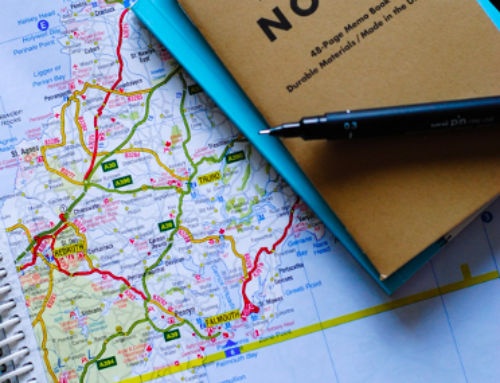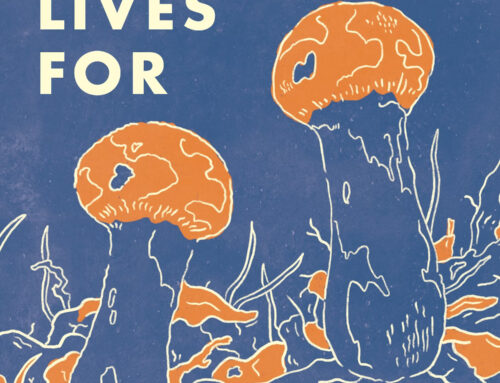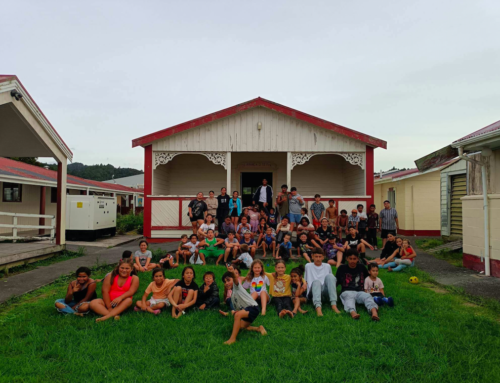Sophie Chao is Discovery Early Career Researcher Award (DECRA) Fellow and Lecturer in the Discipline of Anthropology at the University of Sydney. Her research investigates the intersections of Indigeneity, ecology, capitalism, health, and justice in the Pacific. Sophie is author of In the Shadow of the Palms: More-Than-Human Becomings in West Papua, which received the Duke University Press Scholars of Color First Book Award in 2021. She is co-editor of The Promise of Multispecies Justice with Karin Bolender and Eben Kirksey, also published by Duke University Press. Sophie previously worked for the human rights organization Forest Peoples Programme (FPP) in Indonesia, supporting the rights of forest-dwelling Indigenous peoples to their customary lands, resources, and livelihoods. Her publications at FPP include Conflict or Consent? The Palm Oil Sector at a Crossroads, Divers Paths to Justice: Legal Pluralism and the Rights of Indigenous Peoples in Southeast Asia, and Oil Palm Expansion in Southeast Asia: Trends and Experiences of Local Communities and Indigenous Peoples, all co-edited with Marcus Colchester. For more information about Sophie’s research, please visit http://www.morethanhumanworlds.com/.]
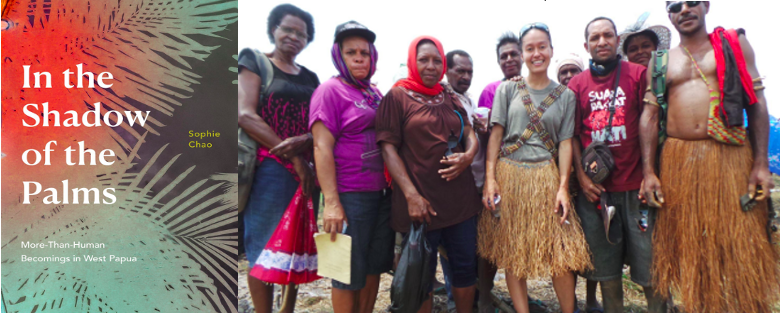
Book cover (left), Sophie Chao, author (right)
Q&A Part I: Theory and Indigenous Knowledge
Kymberley Chu (KC): Dr. Sophie Chao recently authored an ethnographic monograph entitled In the Shadow of the Palms (2022). Her book focuses on tracing palm oil as a cash crop and as a political subject of human exploitation in West Papua, Indonesia. Materially, plastic proliferates almost everywhere and originates from capitalist violence as a multispecies act. To what extent is plastic a metaphor for adaptability, especially with regards to changing or altering multispecies entanglements in plantation worlds?
Sophie Chao (SC): Thank you so much for being in conversation with me, Kym. In the course of my fieldwork in the lowlands of Indonesian West Papua, I was brought to think with the substance of plastic through the onto-epistemologies of the Indigenous Marind People. I’ve had the great privilege to think with and learn from them over the course of this last decade, and their ways and words form the core of my recent book, In the Shadow of the Palms (Chao 2022a). Among this particular community, the concept and substance of plastic is perceived in a primarily negative light. Plastic, as a material and figurative condition of being, conjures concealed deception and uncontrolled proliferation for many of my Marind companions. It is used as a qualifier for foreign foods and people, and also for native animals who are now seeking shelter in Marind villages as their forest habitats give way to industrial oil palm plantations (see Chao 2019).

Animals who take up residence in Marind villages following the destruction of their forest homes are often described as “plastic.” Credits: Sophie Chao
At the same time, one might also theorize plastic, as you suggest, in the sense of plasticity – that is to say, an adaptability to new conditions of life and associated more-than-human entanglements, forged in the rise of the plantation. In the rural district of Merauke, where I’ve been conducting most of my fieldwork, plasticity can help us understand the emergent ecological relationships of organisms who are now learning to coexist with oil palm within industrial monocrops – insects, fungi, rodents, and so forth (see, for instance, Chao 2021a). These critters are forging new modes of co-habitability with the introduced cash crop of oil palm. You could also think about plasticity in the context of Marind people themselves who, while still living according to Indigenous onto-epistemological frameworks, are also learning about oil palm and associated production and supply chains through their interactions with corporations, government actors, NGOs, and anthropologists. Those individuals within the community who have now taken up employment in the palm oil sector have begun to cross-pollinate Indigenous ways of knowing and being with knowledge derived from agronomic science, plant science, and so forth. Plasticity, in the sense of adaptability, is thus also part of the human and more-than-human story of emergent Papuan plantationscapes.
That being said, I think it’s important to remember that adaptability is also intrinsically connected to the broader socio-economic and political conditions that require people to adapt in the first place. When one works in a settler-colonized region like West Papua, attending to these broader conditions brings up complicated and important questions surrounding the kinds of structural violence that make people have to “adapt” and that also set the limits to their ability to adapt. Thinking through socio-environmental transformations through the lens of adaptability or plasticity, then, can be useful if undertaken with caution. The same argument, I think, can be made about narratives anchored in concepts like “resilience” and “capacity-building,” as Jerry Jacka (2015) and Paige West (2016) have illustrated. Such framings can sometimes obscure the structural conditions of diminishment and disempowerment within which acts of adaptation become necessary.
KC: You have written several journalistic and nonprofit policy works before publishing your academic monograph. To what extent does writing across these different mediums and written genres affect how you produce different forms of ethnographic research?
SC: I came to academic research from a prior background in human rights advocacy, having worked as a Project Officer with the UK-based NGO in Indonesia. These prior experiences undergird the ethos of engagement that I strive to sustain in my research, including my attempts to bring my scholarship into conversation with audiences beyond academia – from corporate and government actors to NGO practitioners and the general informed public. This kind of impact-driven engagement, which seeks to foreground Indigenous experiences and theories in the plantation zone for broader publics and targeted stakeholders, is the very least I could do in return for the gift of knowledge entrusted to me by my Papuan companions in the field.
My mode of writing changes across these various mediums and genres in light of the audiences that I imagine these pieces will reach. I consider what these audiences might or might not already know about the oil palm industry and its impacts, for instance, or about Indigenous worldviews regarding what we, in the West, call the “environment.” In crafting non-research outputs, I also think very carefully about the reader’s main takeaway message. If there’s one thing they will remember from this essay or podcast or interview, what should that be?
These are decisions that I try as much as possible to make together with my Marind friends in the field. When I wrote for The Conversation and The Guardian, participated in podcasts, produced trailers for my articles and book, and put together a documentary for Marind land rights campaigners, I shared the drafts and storylines with members of my host community prior to publication. We then decided together which stories to tell, in what order, and which to withhold.
We would also brainstorm who the audiences for these pieces were likely to be, and how their content might be strategically pitched to these different audiences. The idea was to agree collectively not just on the substance or contents of the outputs, but also on the ways in which they would be communicated. For me, these kinds of conversations and joint decision-making processes are absolutely central to practicing engaged anthropology in a responsible manner.
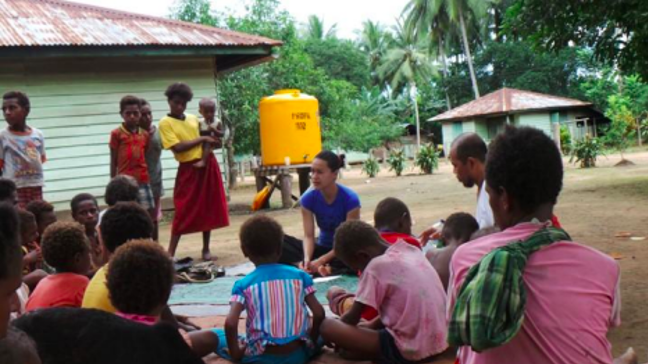
Consulting with community members on publishing strategies in rural Merauke. This photo was reproduced with permission. Credits: Mina Basik-Basik
Two formats that have pushed me to think more creatively about scholarly knowledge communication are podcasts and trailers. Podcasts are fantastic because they offer a space for dialogue and conversation, rather than a one-way mode of transmission. As audio-based media, podcasts have also allowed me to incorporate what textual mediums cannot. I’m thinking here of podcasts where we incorporated sounds from the forests with whom Marind entertain intimate and ancestral relationships of kinship – the sound (or in Marind terms, the “voices”) of rivers, wind, or people talking, singing, wailing sometimes. To include these bio-acoustics within a podcast totally aligns with the multisensory epistemology that Marind themselves deploy in encountering and understanding the forest and themselves in relation to it.
A second format that I’ve enjoyed experimenting with these last few years is trailers for my articles and recent book. Trailers bring into the fold the visual dimensions of the field and of fieldwork in ways that, as with sound, written texts cannot necessarily or always fully convey. The four-minute trailer for my book tries to bring to life the kinesthetics of the Upper Bian region – its people, landscapes, stories, children, rituals, and more. The process of making this trailer made me think in unexpected ways about the art of visual representation – which footage to keep or exclude, how to sustain a rhythm to the storyline, what kind of music to use, and what kinds of questions and moods I wanted to conjure for the viewer. I think it would be marvelous if we got into the habit of making short trailers for our scholarly publications, including as a way of better capturing and communicating affective core of these works.
Q&A Part II: Epistemic Resistance
KC: Sophie, could you expand on your understanding of epistemic empowerment according to the book? In what ways are our ethnographic interlocutors able to cultivate a sense of epistemic empowerment, given the heavy degree of extraction that anthropology relies on?
SC: One of the key ethical stakes of my research is to push against the binarization and hierarchization of theory and ethnography. As I write in my book (Chao 2022a, 7), theory is routinely “taken to be “produced” by (and often for) the Global North, based on ethnographic realities that “happen” in the Global South.” Framing Indigenous peoples as theorists – in this instance, my Marind interlocutors – was really important to me in terms of acknowledging that frameworks for understanding the world are being produced not just about, but also in the fields where we conduct our research (see also Chao and Enari 2021). In my understanding, the job of the anthropologist is as much to articulate their own analysis and theories about life as it is to do justice to those theories being articulated by the very same communities and people in the field who make our research possible and meaningful.
Following Carole McGranahan (2022), I understand “theory” in the broadest sense to encompass the diverse ways in which people interpret and make claims in and about the world. To acknowledge Marind as theorists, alongside other intellectuals, practitioners, and activists cited in my book, counters what Simione Durutalo (1992, 207–208) and Teresia Teaiwa (2006, 75) call the “elimination of innovation” in representations of Pacific peoples that fail to “account for changes in [I]ndigenous ways of knowing and being.” Instead, it recognizes the complex, transforming, and praxis-based interpretive frameworks through which our interlocutors, as active knowledge producers, understand, explain, and evaluate the nature of, and relationship between, local realities and global forces, as these arise through their identification of meaningful connections, resonances, gaps, and contradictions – some lived and remembered, others imagined and speculative.
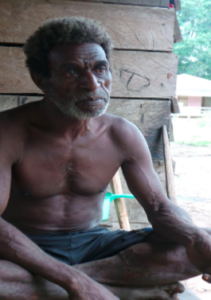
An Indigenous Marind elder describing oil palm’s multiple identities as violent invader, victim of violence, and object of curiosity. Credits: Sophie Chao
In the book and elsewhere, I’ve tried to draw attention to Indigenous theory-making as a form of situated knowledge production and as a form of epistemic resistance to the racializing, simplifying, and disciplining logic of the plantation itself and its colonial-capitalist undergirdings.
Epistemic resistance manifests, for instance, in the ways in which Marind theorize oil palm. This introduced cash crop is taking over Marind’s lands and forests to the detriment of their more-than-human lifeworlds and of the intimate and ancestral kinships that animate and sustain these lifeworlds. And yet even as they are subject to oil palm’s destructive effects, Marind refuse to reduce this plant to any singular or static identity or ontology. They express resentment and fear towards oil palm, but also pity and compassion because they see that it, too, is subjected to human, technological, institutional, and economic control and violence that dictate its life and death, from seedling to commodity.
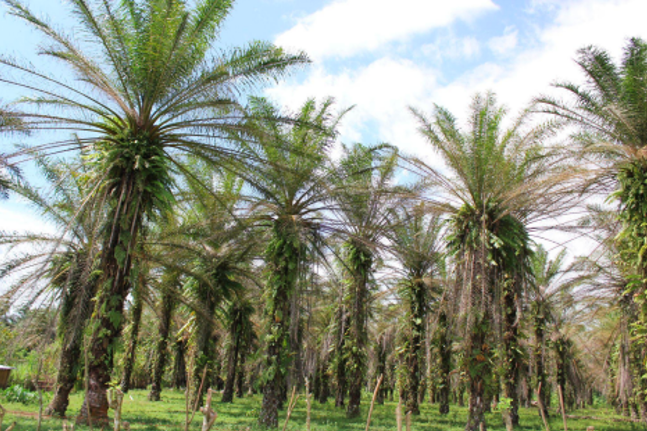
An oil palm plantation in rural Merauke. Credits: Sophie Chao
Another form of epistemic resistance manifests in the context of Marind cartographic practices, which villagers are undertaking as part of their advocacy efforts to reclaim their territories from predatory state and corporate actors (Chao 2022, 51-74; see also Chao 2017). These maps, which I participated in producing, are shaped not just by physical sites, but also by the sounds that enliven this landscape, and which Marind insist must be included within cartographic representations. GPS coordinates mark out a location of significance – like a sacred sago grove or a ceremonial burial site – but they also include sound clips that capture its bio-acoustics, together with the stories and songs that amplify its cultural and ecological significance. This kind of multisensory mapping pushes against the ocularcentrism and top-down perspective of conventional 2D maps. It draws our attention to the sounds (and not just the sights) that matter to Marind, and through which the cartographers remember and celebrate their relationships to the sentient landscape.
Yet a third example of epistemic resistance that I documented in the field pertains to the emergent practices of “multispecies mourning,” wherein villagers sing, story, and bury animals killed by the plantation or on the roads built within and between oil palm concessions (Chao 2022b). Mourning animals and plants matters to Marind because it marks a refusal not to mourn lives deemed killable and ungrievable under technocapitalist regimes. It counts as a form of “radical care,” to borrow Julia Hobart and Tamara Kneese’s (2020) term, that reckons with the enormity of deaths that go completely unacknowledged in the wake of the plantation, and that rob plants and animals of dignity and pride.
Let me now turn to the latter part of your question on anthropology and/as extractivism. Navigating the path between extractivism and integrity, in all its ethical, political, epistemic, and methodological dimensions, is something that I continue to struggle with, and that I cannot assume to have done well – or well enough. As you hint to, anthropology is haunted not only by a logic of extractive “knowledge capitalism,” to borrow Makere Stewart-Harawira’s (2013) term, but also by a deeply unsettling trope of the “heroic fieldworker” (Douglas-Jones, Mathur, Trundle et al. 2020) – a figure that continues to exist and be imagined as White, male, and privileged.
My attempts to push against this extractive and racialized paradigm were multi-pronged. They included involving my Marind friends in the design of the research project, methods, and questions from the very outset – from co-drafting human ethics applications, to discussing writings in detail prior to publication, and deciding jointly which stories would be made public, where, for what reason, and sometimes, why not. I also sought to remain faithful in my writing to the deeply poetic and philosophical ways in which Marind story and critique their rapidly changing environments and lives – not to overload the writing with Western theoretical jargon, but rather to stick to Marind’s own concepts and terms for the worlds they inhabit and the relations these worlds make and unmake. I further paired my research with engaged activities in support of Marind’s grassroots land rights campaigns: I facilitated participatory mapping workshops, translated petitions and complaints, and contributed to international news and media platforms. These were efforts to level a deeply uneven field of power between myself and my companions – even as this field remains rife with structural inequities, and even as the book, ultimately, is individual in that its many human and other-than-human contributors cannot be named as authors, both because of existing strictures within publishing conventions and because of the very real risks to the safety and security of my friends in the field that might accompany their identification.
For a non-Indigenous scholar like myself, operating within a discipline (anthropology) that has historically been instrumental to furthering colonial agendas, the labor of reimagining more-than-human relationality has demanded that I attempt to do justice in my writings to the richly complex and transforming ways in which Indigenous peoples themselves experience, understand, and contest the attritive effects of colonial-racial-capitalist regimes on Indigenous ways of being, thinking, and doing. Just as importantly, it has meant centering in my work the knowledges of Indigenous scholars and practitioners, in a collective effort to challenge the hegemony and boundaries of established intellectual canons. Thinking with Indigenous scholars brings to the fore oft-effaced dimensions of more-than-human coexistence. I’m thinking here, among many other key scholars, of Christine Winter’s (2019) framing of plants, animals, and land as subjects of dignity, Stewart-Harawira’s (2012) attention to the sacrality of ecology within Indigenous spiritualities, Max Liboiron’s (2021) critique of the ambiguous alignment of environmental science with the colonial project, and Kim TallBear’s (2011) invitation to think beyond “species” in reimagining planetary animacies. Engaging with Indigenous scholarship is a vital part of the labor of decanonizing the field, which may in turn offer a small step in the labor of decolonizing our disciplines.
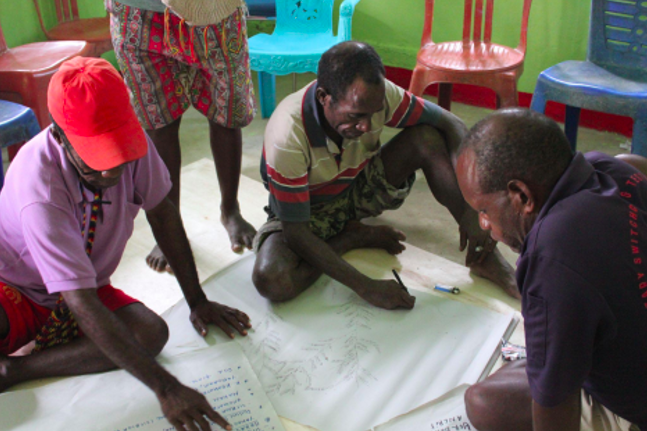
Marind villagers producing a community map of their customary lands and territories. Credits: Sophie Chao
KC: What do we learn from the cultural assumptions surrounding the definition of what an animal should be as plantation worlds alter interspecies relationality?
SC: More generally, I have increasingly found the framing of “species” (including “multispecies”) limited in understanding more-than-human worlds (see Price and Chao forthcoming). These idioms help expand the scope of subjects within an “anthropology of life,” and yet they also restrict that scope to categories of being that fall within dominant secular science considers to be life, or bios. I think it’s important to think beyond bios, not just (or even at all) with the categories of animal or plant or human, but rather with ideas of eco-relationality, with elements, ancestors, the deceased, ghosts, monsters, and the many other non-secular and non-bios beings who are also part of what Robin Wall Kimmerer (2014) calls the “grammar of animacy.”
One recent work that has helped me think through these questions is Felicity A. Schaeffer’s Unsettled Borders (2022), which offers the language of “sacredscience” to describe Indigenous onto-epistemologies. The concept of sacredscience pushes against the alienation of science from the sacred within Western knowledge paradigms. Instead, it draws attention to how Indigenous knowledge systems integrate biological knowledge and spiritual cosmologies in ways that account for “the lively presence and knowledge of wind patterns, animal habits and behaviors, the edible parts of animals and plants, plant growth, star patterns, and what all life forces need to survive, propagate themselves, and thrive” (Schaeffer 2022, 17-18). It is this refusal to segregate science from the sacred, Schaeffer notes, that fosters better ways of remaining responsible to the more-than-human world and respecting “the relational web and life force that holds us all together” (ibid.).
Chapter 4 (Chao 2022a, 95-114) traces the strange life and fate of a young cassowary called Ruben. Ruben was one of many forest animals who are now approaching Marind villages in search of shelter and subsistence following the razing of their native habitats. These animals are taken in and nurtured by Marind. But they also give rise to ambiguous or ambivalent affects among their keepers. That ambiguity arises from the changes that Marind read in the behavior of village-bound creatures who were formerly wild and living with their kin in the forest, but that are now restricted to the human space of the village and are therefore said to have lost their freedom and autonomy.
Marind’s ambiguous response to village animals points to their understanding of domestication as a form of violence – one that limits the ability of animals to exist as persons and as relations within the space of wilderness that is the forest. This idiom of wilderness is one that Marind themselves deploy in everyday discourses. It is different from the critique of wilderness as a Western construct anchored in a nature-culture divide, as put forth by William Cronon (1996) and others. Among Marind, wilderness is associated with freedom. It is a valued attribute among both human and other-than-human beings that should be respected and sustained.
When it comes to village-bound creatures like Ruben, the loss of freedom and wilderness of animals speaks in troubling ways to Marind’s own loss of autonomy and freedom as coerced citizens of the occupying Indonesian nation-state. Village animals, as such, become problematic indexes for the theft of freedom of their human keepers. Therein arise their ambivalent material-semiotic valences. Marind theorizations of wild and domesticated creatures I think raise some important questions around what an animal should be, how its lifeway should enfold, what kinds of relations sustain its autonomy, and what kinds of troubling analogies are forged when animals and humans form shared communities of fate in the face of technocapitalist incursions and attendant transformations.

The Marind lifeworld is animated by humans, animals, and plants, but also by sentient rivers, soils, rocks, and spirits. Credits: Sophie Chao
KC: As consumers of palm oil products, we often do not see the underlying exploitative labor conditions utilized in its cultivation processes. Some of us might see each other as “passive consumers” of palm oil under late capitalism, while others such as the Indigenous Marind communities view palm oil as a malicious plant with agency/capacities. How do we make sense of these overlapping cosmologies?
SC: I’m still myself grappling with what it means to take seriously different ontologies and what it takes to think transversely across different realities and representations. One of the most challenging dimensions of my fieldwork was this precisely – to take seriously the fact that Marind understand native forest plants and animals as agentive persons. This includes the agency of oil palm, a plant that Marind affirm has its own dispositions, desires, and needs, even if does not have a place within their traditional landscapes and livelihoods.
Oil palm, too, inhabits multiple realities in Marind worldviews. Its ontology, as I write elsewhere, is dispersed (Chao 2018, 2020). This is a plant that Marind resent and fear for its destructive impacts, but one that they also pity as a being captured and possessed by the spirit of capitalism. Oil palm kills the lifeworld of the beings whose environments it occupies – and yet it, too, is reduced in the process from a historical agent to passive capital. It is extracted, exploited, uprooted, and transplanted to serve human interests and needs. It is thus both a victim and a driver of violence. Rather than an “either or,” this is a plant that exists to Marind as a series of ands: plant and person, victim and assailant, near-kin and alien-colonist.
Certainly, the exploitative labor conditions that you’ve described, together with the global production and consumption of palm oil, are also part of the story. Marind themselves associate the plantation sector with racial discrimination – from the paternalistic discourses of “development” and “progress” that accompany its expansion, to the exclusion of Indigenous inhabitants from employment opportunities, to the substitution of valued forest foods with supposedly more “civilized” Indonesian or Western commodities (see Chao 2021b, c). Indeed, Marind themselves are now participating in what Simryn Gill and Michael Taussig (2017) call a global “becoming palm.” They, too, are increasing their consumption of palm oil in the instant noodles, cookies, and other imported foods that are now replacing their forest subsistence.
There is thus a deep impurity at play in the story of the oil palm sector – an impurity that is differentially distributed across space and time, and that invites us to identify connections between our own everyday lives as consumers and the lives of people like the Marind who inhabit what Val Plumwood (2008) calls the “shadow places” of agroindustrial capitalism. These kinds of patchy, partial connections can act as important starting points for meaningful conversations about situatedness, relationality, and violence, even as our capacity as consumers to make a difference in plantation-based production remains very limited.

Commodities like palm oil connect us to out-of-the-way resource frontiers like West Papua, where industrial monocrops are undermining conditions of life for Indigenous communities and their other-than-human kin. Credits: Sophie Chao
Q&A Part III: Extractivism in Anthropology
KC: Reflecting on both In the Shadow of the Palms and your edited volume, The Promise of Multispecies Justice, how do we cultivate different versions of multispecies justice in the worlds we inhabit?
SC: Thank you for the shoutout to this exciting new volume, Kym. The Promise of Multispecies Justice to me is a beautiful example of what coalitional, cross-disciplinary, and collaborative thinkfeel can offer, in and against an age of ecological unmaking. The collection draws together leading and emerging thinkers in anthropology, geography, philosophy, speculative fiction, poetry, and contemporary art, who are all asking themselves from their diversely grounded locations: How do social justice struggles intersect with the lives of animals, plants, and other creatures? How can we move beyond juridical and anthropocentric notions of justice? What might it take for other-than-human beings to count as subjects before the law? In other words, what possibilities exist for achieving multispecies justice?
A diverse array of material-semiotic figures animate The Promise of Multispecies Justice: from pesticides, stray dogs, and viruses to nuclear waste, rodent traps, and prison gardens, among others. Each of these entities, as the authors demonstrate, help us think about justice in more-than-human terms, in all its situatedness and patchiness. For if there’s one thing that unites the chapters, it is that justice is always inherently partial – it is more of some worlds than of others. There is, as such, no justice in the singular, but rather multiple, intersecting (in)justices that each produce particular kinds of frictions and alliances, pitfalls and possibilities.

Cover of The Promise of Multispecies Justice and link to the book website at https://multispeciesjustice.space/
Some of the authors in our collective call for justice through mundane everyday acts of care. Others propose justice through radical and sweeping structural reforms, through the transformation of legal paradigms, or through micro-biopolitical modes of bettering—rather than ending—interspecies conflicts. Some invite us to consider how multispecies justice relates to situated understandings and assessments of what counts as killable, but also what constitutes a “good” life and a “good” death, or a “bad” life and a “bad” death, and their respective afterlives. Others demand our attention to those injustices deemed tolerable and intolerable, proportional or disproportional, and commensurable or incommensurable. Many of the contributions problematize the threshold of (in)justice and who gets to determine it. They interrogate possibilities for just interspecies relations even in the absence of any sense of empathy, care, or kinship-based affinities. They call on us to theorize justice beyond the human without neglecting what Paul Gilroy (2017, 10) calls “our obligation to the bloody archive of suffering under racial orders and their colonial nomoi.”
In our collection, we also index multiple species of justice, reclaiming modest forms of hope through accounts of multiworld justice, small justice, generative justice, and spectral justice, among others. The idea here is to explore tactics for achieving multispecies justice in polymorphic situations where calculations are never perfect, and often open to reinterpretation – not in a state that can be achieved once and for all, but rather one that is always already political and partial. Nomadic aesthetics inform this curatorial practice. Taken together, the essays and poems tell stories that jump scales, sites, and subjects, moving from abstract speculation to situated political action and material intervention, and then back again. The authors show that it is possible to care for particular forms of life and biocultural communities, while at the same time holding onto promises of sweeping change on future horizons. They offer approaches to multispecies justice that are anchored in the ongoing practice of being open and alive to the generative possibilities of each encounter. They invite us to think carefully and collectively about which dreams of justice are worth dreaming – and by extension, which injustices are intolerable. They call on us to renew our commitment to love, to live, and to fight for the possibility of flourishing in worlds present and yet to come. As my wonderful co-editor Karin Bolender writes so beautifully in the volume’s Afterword (Bolender, Chao, and Kirksey 2022, 237), it is at the frayed edges, perimeters, and in the spaces-between human justices that “we just might recognize previously unheard voices of myriad insects, plants, waterways, forests, spores, and other outlaws, singing their own corridos—old songs of love and loss, daring escapes and even little justices: recalled, remembered, lived in and longed for.”

A Marind father and his children journeying to the forest to fish and forage. Credits: Sophie Chao
Acknowledgement
Sophie Chao acknowledges the custodians of the lands on which she works and lives, the Gadigal people of the Eora Nation and the Darramuragal people of the Darug nation. She offers her respects to their elders past, present, and emergent, and to their kin – human, vegetal, animal, and elemental. The lands of Gadigal and Darramuragal were taken without consent, treaty, or compensation. They are lands whose stories have historically been stolen, silenced, and sanitized. They are lands of ongoing Indigenous survivance, continuance, persistence, and resurgence. Indigenous lands. Always have been. Always will be.
References
Bolender, Karin, Sophie Chao, and Eben Kirksey. “Afterword: Fugitive Jurisdictions.” In Chao, Sophie, Eben Kirksey, and Karin Bolender, eds. 2022. The Promise of Multispecies Justice. Durham, NC: Duke University Press. Pp. 229–238.
Chao, Sophie. 2017. “There Are No Straight Lines in Nature: Making Living Maps in West Papua.” Anthropology Now 9 (1): 16 – 33.
Chao, Sophie. 2018. “In the Shadow of the Palm: Dispersed Ontologies Among Marind, West Papua.” Cultural Anthropology 33 (4): 621–49.
Chao, Sophie. 2019. “The Plastic Cassowary: Problematic ‘Pets’ in West Papua.” Ethnos 84 (5): 828–48.
Chao, Sophie. 2020. “A Tree of Many Lives: Vegetal Teleontologies in West Papua.” HAU: Journal of Ethnographic Theory 10 (2): 514–29.
Chao, Sophie. 2021a. “The Beetle or the Bug? Multispecies Politics in a West Papuan Oil Palm Plantation.” American Anthropologist 123 (2): 476 – 489.
Chao, Sophie. 2021b. “Gastrocolonialism: The Intersections of Race, Food, and Development in West Papua.”International Journal of Human Rights 26 (5): 811–32.
Chao, Sophie. 2021c. “We Are (Not) Monkeys: Contested Cosmopolitical Symbols in West Papua.” American Ethnologist48 (3): 274–87.
Chao, Sophie. 2022a. In the Shadow of the Palms: More-Than-Human Becomings in West Papua. Durham, N.C.: Duke University Press.
Chao, Sophie. 2022b. “Multispecies Mourning: Grieving as Resistance on the West Papuan Oil Palm Frontier.” Cultural Studies, 1–27.
Chao, Sophie, Karin Bolender, and Eben Kirksey, eds. 2022. The Promise of Multispecies Justice. Durham, N.C.: Duke University Press.
Chao, Sophie, and Dion Enari. 2021. “Decolonising Climate Change: A Call for Beyond-Human Imaginaries and Knowledge Generation.” ETropic: Electronic Journal of Studies in the Tropics 20 (2): 32–54.
Cronon, William. 1996. “The Trouble with Wilderness: Or, Getting Back to the Wrong Nature.” Environmental History 1 (1): 7–28.
Douglas-Jones, Rachel, Nayanika Mathur, Catherine Trundle, and Tarapuhi Vaeau. 2020. “Trial by Fire: Trauma, Vulnerability and the Heroics of Fieldwork.” Commoning Ethnography 3 (1): 91–116.
Durutalo, Simone. 1992. “Anthropology and Authoritarianism in the Pacific Islands.” In Confronting the Margaret Mead Legacy: Scholarship, Empire, and the South Pacific, edited by Lenora Foerstel and Angela M. Gilliam, 205–32. Philadelphia, P.A.: Temple University Press.
Gill, Simryn, and Michael Taussig. 2017. Becoming Palm. Singapore and Berlin: NTU Centre for Contemporary Art Singapore and Sternberg Press.
Gilroy, Paul. 2017. “‘Where Every Breeze Speaks of Courage and Liberty’: Offshore Humanism and Marine Xenology, or, Racism and the Problem of Critique at Sea Level.” Antipode 50 (1): 3–22.
Hobart, Hi’ilei J. K., and Tamara Kneese. 2020. “Radical Care: Survival Strategies for Uncertain Times.” Social Text 38 (1): 1–156.
Jacka, Jerry K. 2015. Alchemy in the Rainforest: Politics, Ecology, and Resilience in a New Guinea Mining Area. Durham, N.C.: Duke University Press.
Kimmerer, Robin W. 2014. Braiding Sweetgrass: Indigenous Wisdom, Scientific Knowledge, and the Teachings of Plants. Minneapolis, M.N.: Milkweed Press.
Liboiron, Max. 2021. Pollution Is Colonialism. Durham, N.C.: Duke University Press.
McGranahan, Carole. 2022. “Theory as Ethics.” American Ethnologist 49 (3): 289–301.
Plumwood, Val. 2008. “Shadow Places and the Politics of Dwelling.” Australian Humanities Review, no. 44: 139–50.
Price, Catherine and Sophie Chao. forthcoming. “Multispecies, More-than-human, Non-human, Other-than-human: Reimagining Idioms of Animacy in an Age of Planetary Unmaking.” Exchanges: The Interdisciplinary Research Journal.
Schaeffer, Felicity A. 2022. Unsettled Borders: The Militarized Science of Surveillance on Sacred Indigenous Land. Durham, NC: Duke University Press.
Simpson, Leanne B. 2016. “Indigenous Resurgence and Co-Existence.” Journal of the Critical Ethnic Studies Association2 (2): 19–34.
Stewart-Harawira, Makere. 2012. “Returning the Sacred: Indigenous Ontologies in Perilous Times.” In Radical Human Ecology: Intercultural and Indigenous Approaches, edited by Rose Roberts and Lewis Williams, 94–109. New York: Taylor & Francis.
Stewart-Harawira, Makere. 2013. “Challenging Knowledge Capitalism: Indigenous Research in the 21st Century.” Socialist Studies 9 (1): 39–51.
TallBear, Kim. 2011. “Why Interspecies Thinking Needs Indigenous Standpoints.” Fieldsights.https://culanth.org/fieldsights/260-why-interspecies-thinking-needs-indigenous-standpoints.
Teaiwa, Teresia K. 2006. “On Analogies: Rethinking the Pacific in a Global Context.” Contemporary Pacific Studies 18 (1): 71–87.
Tuck, Eve, and Wayne K. Yang. 2016. “What Justice Wants.” Journal of the Critical Ethnic Studies Association 2 (2): 1–15.
Tuhiwai Smith, Linda. 2012. Decolonizing Methodologies: Research and Indigenous Peoples. New York: Zed Books.
West, Paige. 2016. Dispossession and the Environment: Rhetoric and Inequality in Papua New Guinea. New York: New York University Press.
Winter, Christine J. 2019. “Decolonising Dignity for Inclusive Democracy.” Environmental Values 28: 9–30.
Kymberley “Kym” Chu is an Anthropology PhD student at Princeton University. Her current doctoral research focuses on the commodification of scientific and agricultural animals across various workplaces in Malaysia. Previously, she focused on tracing environmental histories of dispossession for media outlets such as Deutsche Welle, The Ecologist, and Sentient Media. Follow her on Twitter at https://twitter.com/ChuKymberley.
Cite As: Chu, Kymberley and Chao, Sophie. 2023. “Palm Oil Worlds: An Interview with Dr. Sophie Chao” American Ethnologist website, 13 Feb 2023 [https://americanethnologist.org/online-content/interviews/an-interview-with-dr-sophie-chao-on-palm-oil-worlds/]

